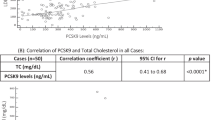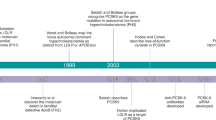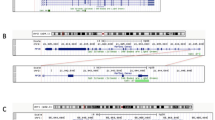Abstract
Autosomal dominant hypercholesterolemia (ADH) is characterized by isolated increase in plasmatic low-density lipoprotein (LDL) cholesterol levels associated with high risk of premature cardiovascular disease. Mutations in LDLR, APOB, and PCSK9 genes have been shown to cause ADH. We now report further genetic heterogeneity of ADH through the study of a large French family in which the involvement of these three genes was excluded. A genome-wide scan mapped the disease-causing gene, named HCHOLA4, at 16q22.1 in a 7.89-Mb interval containing 154 genes with a maximum LOD score of 3.9. To reduce the linked region, we genotyped 18 smaller non-LDLR/non-APOB/non-PCSK9-ADH families at the HCHOLA4 locus. Six families did not exclude linkage to the locus, but none allowed reduction of the disease interval. The 154 regional genes were sorted according to the function of the encoded protein and tissue expression profiles, and 57 genes were analyzed through sequencing of their coding region and close flanking intronic parts. No disease-causing mutation was identified in these families, particularly in the LCAT gene. Finally, our results also show the existence of other ADH genes as nine families were neither linked to LDLR, APOB, and PCSK9 genes nor to the new HCHOLA4 locus.
Similar content being viewed by others
Log in or create a free account to read this content
Gain free access to this article, as well as selected content from this journal and more on nature.com
or
References
Goldstein JL, Brown MS : Familial hypercholesterolemia: identification of a defect in the regulation of 3-hydroxy-3-methylglutaryl coenzyme A reductase activity associated with over production of cholesterol. Proc Natl Acad Sci USA 1973; 70: 2804–2808.
Brown MS, Goldstein JL : A receptor-mediated pathway for cholesterol homeostasis. Science 1986; 232: 34–37.
Soria LF, Ludwig EH, Clarke HR, Vega GL, Grundy SM, McCarthy BJ : Association between a specific apolipoprotein B mutation and familial defective apolipoprotein B-100. Proc Natl Acad Sci USA 1989; 86: 587–591.
Varret M, Rabes JP, Saint-Jore B et al: A third major locus for autosomal dominant hypercholesterolemia maps to 1p34.1-p32. Am J Hum Genet 1999; 64: 1378–1387.
Abifadel M, Varret M, Rabes JP et al: Mutations in PCSK9 cause autosomal dominant hypercholesterolemia. Nat Genet 2003; 34: 154–156.
Allard D, Amsellem S, Abifadel M et al: Novel mutations of the PCSK9 gene cause variable phenotype of autosomal dominant hypercholesterolemia. Hum Mut 2005; 26: 497–507.
Cohen J, Pertsemlidis A, Kotowski IK, Graham R, Garcia CK, Hobbs HH : Low LDL cholesterol in individuals of African descent resulting from frequent nonsense mutations in PCSK9. Nat Genet 2005; 37: 161–165.
Lambert G, Charlton F, Rye KA, Piper DE : Molecular basis of PCSK9 function. Atherosclerosis 2009; 203: 1–7.
Dib C, Faure S, Fizames C et al: A comprehensive genetic map of the human genome based on 5,264 microstaellites. Nature 1996; 380: 152–154.
Weeks DE, Ott J, Lathrop GM : SLINK: a general simulation program for linkage analysis. Am J Hum Genet 1990; 47: A204.
O’Connell JR, Weeks DE : PedChek: a program for identification of genotype incompatibilities in linkage analysis. Am J Hum Genet 1998; 63: 259–266.
Fishelson M, Geiger D : Exact genetic linkage computations for general pedigrees. Bioinformatics 2002; 18: S189–S198.
Weeks DE, Sobel E, O’Connell JR, Lange K : Computer programs for multilocus haplotyping of general pedigrees. Am J Hum Genet 1995; 56: 1506–1507.
Lindner TH, Hoffmann K : EasyLinkage: a PERL script for easy and automated two-/multi-point linkage analyses. Bioinformatics 2005; 21: 405–407.
Kruglyak L, Daly MJ, Reeve-Daly MP, Lander ES : Parametric and nonparametric linkage analysis: a unified multipoint approach. Am J Hum Genet 1996; 58: 1347–1363.
Kong A, Cox NJ : Allele-sharing models: LOD scores and accurate linkage tests. Am J Hum Genet 1997; 61: 1179–1188.
Collod G, Babron MC, Jondeau G et al: A second locus for Marfan syndrome maps to chromosome 3p24.2-p25. Nat Genet 1994; 8: 264–268.
Albers JJ, Chen CH, Lacko AG : Isolation, characterization and assay of lecithin : cholesterol acyltransferase. Methods Enzymol 1986; 129: 763–783.
Sass C, Giroux LM, Ma Y et al: Evidence for a cholesterol-lowering gene in a French-Canadian kindred with familial hypercholesterolemia. Hum Genet 1995; 96: 21–26.
Hobbs HH, Leitersdorf E, Leffert CC, Cryer DR, Brown MS, Goldstein JL : Evidence for a dominant gene that suppresses hypercholesterolemia in a family with defective low density lipoprotein receptors. J Clin Invest 1989; 84: 656–664.
Aulchenko YS, Ripatti S, Lindqvist I et al: Loci influencing lipid levels and coronary heart disease risk in 16 European population cohorts. Nat Genet 2009; 41: 47–55.
Willer CJ, Sanna S, Jackson AU et al: Newly identified loci that influence lipid concentrations and risk of coronary artery disease. Nat Genet 2008; 40: 161–169.
Wallace C, Newhouse SJ, Braund P et al: Genome-wide association study identifies genes for biomarkers of cardiovascular disease: serum urate and dyslipidemia. Am J Hum Genet 2008; 82: 139–149.
Sandhu MS, Waterworth DM, Debenham SL et al: LDL-cholesterol concentrations: a genome-wide association study. Lancet 2008; 371: 483–491.
Aberg K, Dai F, Sun G et al: A genome-wide linkage scan identifies multiple chromosomal regions influencing serum lipid levels in the population on the Samoan islands. J Lipid Res 2008; 49: 2169–2178.
Hsiao CF, Chiu YF, Chiang FT et al: Genome-wide linkage analysis of lipids in nondiabetic Chinese and Japanese from the SAPPHIRe family study. Am J Hypertens 2006; 19: 1270–1277.
Kirchhausen T : Adaptors for clathrin-mediated traffic. Annu Rev Cell Dev Biol 1999; 15: 705–732.
Kirchhausen T : Clathrin adaptators really adapt. Cell 2002; 109: 413–416.
Garcia CK, Wilund K, Arca M et al: Autosomal recessive hypercholesterolemia caused by mutations in a putative LDL receptor adaptor protein. Science 2001; 292: 1394–1398.
Doray B, Ghosh P, Griffith J, Geuze HJ, Kornfeld S : Cooperation of GGAs and AP-1 in packaging MPRs at the trans-Golgi network. Science 2002; 297: 1700–1703.
Babst M, Katzmann DJ, Snyder WB, Wendland B, Emr SD : Endosome-associated complex, ESCRT-II, recruits transport machinery for protein sorting at the multivesicular body. Dev Cell 2002; 3: 283–289.
Hrboticky N, Feldmeer T, Essler M, Wiedemann A, Aepfelbacher M : Involvement of the GTPase Rho in the cellular uptake of low density lipoprotein by human skin fibroblasts. Biochim Biophys Acta 2002; 1580: 123–132.
van Weert AW, Dunn KW, Gueze HJ, Maxfield FR, Stoorvogel W : Transport from late endosomes to lysosomes, but not sorting of integral membrane proteins in endosomes, depends on the vacuolar proton pump. J Cell Biol 1995; 130: 821–834.
Kaech SM, Whitfield CW, Kim SK : The LIN-2/LIN-7/LIN-10 complex mediates basolateral membrane localization of the C. elegans EGF receptor LET-23 in vulval epithelial cells. Cell 1998; 94: 761–771.
Kim SK : Polarized signaling: basolateral receptor localization in epithelial cells by PDZ-containing proteins. Curr Opin Cell Biol 1997; 9: 853–859.
Varret M, Abifadel M, Rabès JP, Boileau C : Genetic heterogeneity of autosomal dominant hypercholesterolemia. Clin Genet 2008; 73: 1–13.
Acknowledgements
We thank the family members for their cooperation. This work was supported by grants from Pfizer, Fondation de France, GIS-Maladies Rares, PHRC (AOM06024), and ANR (ANR-05-PCOD-017, ANR-06-MRAR-038, ANR-08-GENO-002-01). AM-P and MM are supported by a grant from the Ministère de l’Education Nationale et de la Technologie (France). MA is supported by grants from Région Ile de France and Conseil de la Recherche de l’Université Saint-Joseph (Beirut, Lebanon).
Author information
Authors and Affiliations
Consortia
Corresponding author
Ethics declarations
Competing interests
The authors declare no conflict of interest.
Additional information
Supplementary Information accompanies the paper on European Journal of Human Genetics website
Supplementary information
Rights and permissions
About this article
Cite this article
Marques-Pinheiro, A., Marduel, M., Rabès, JP. et al. A fourth locus for autosomal dominant hypercholesterolemia maps at 16q22.1. Eur J Hum Genet 18, 1236–1242 (2010). https://doi.org/10.1038/ejhg.2010.94
Received:
Revised:
Accepted:
Published:
Issue date:
DOI: https://doi.org/10.1038/ejhg.2010.94
Keywords
This article is cited by
-
Genetic determinants of inherited susceptibility to hypercholesterolemia – a comprehensive literature review
Lipids in Health and Disease (2017)
-
Genetics of Familial Hypercholesterolemia
Current Atherosclerosis Reports (2015)
-
From Human-Induced Pluripotent Stem Cells to Liver Disease Modeling: A Focus on Dyslipidemia
Current Pathobiology Reports (2015)
-
Novel and recurrent LDLR gene mutations in Pakistani hypercholesterolemia patients
Molecular Biology Reports (2012)



